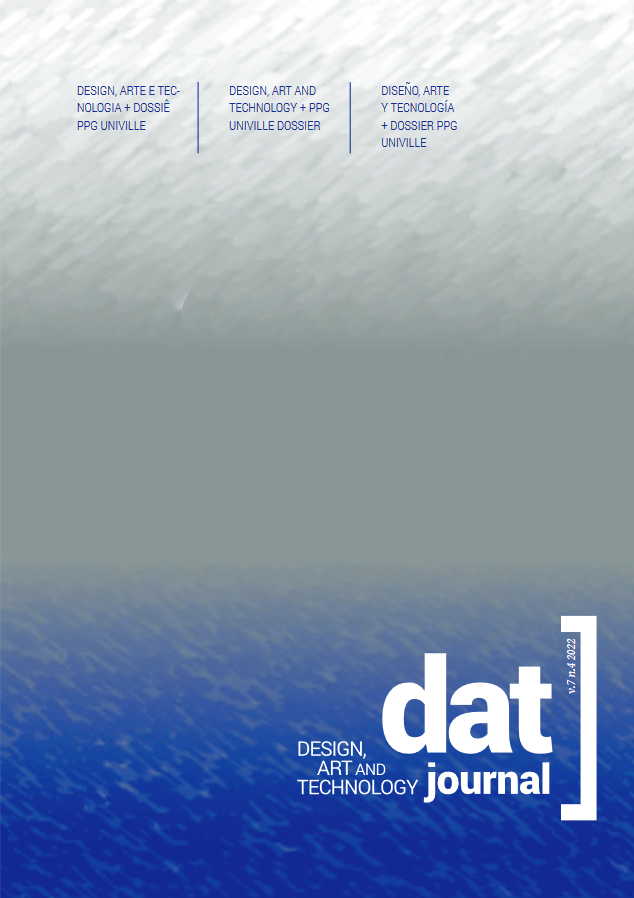The human-centered design and the challenges for human-computer interaction from ISO 9241-210:2019
DOI:
https://doi.org/10.29147/datjournal.v7i4.559Keywords:
Human-Centred Design, Human-Cpmputer Interaction, ISO, User Experience, Universal DesignAbstract
ISO 9241-210:2019 represents the state of the art in human-centered design approach. This article presents the results of the analysis of the changes in ISO's approach to human-centered design activities, providing subsidies to understand contemporary challenges in the field of design. In the discourse analysis of the historical series – ISO 13407:1999, ISO 9241-210:2010, and ISO 9241-210:2019 –, we concluded that there is a close relationship between the design of human-system interaction, as discussed in the document, and , respectively, the principles of human factors/ergonomics (1999), the user experience (2010) and universal design (2019). Due to accelerated social and environmental changes and constant technological advancement, the ISO standard for human-system interaction design should be understood more as a matrix than a paradigm for projects that seek alignment with the challenges that will be in the blind spot of the standard until the your next update.
Downloads
References
BARANAUSKAS, M. C. C.; ROCHA, H. V. Design e Avaliação de Interfaces Humano-Computador. Campinas, SP: Univ. Est. de Campinas, 2003. Disponível em: https://www.nied.unicamp.br/biblioteca/design-e-avaliacao-de-interfaces-humano-computador/. Acesso: fev. 2021.
BENJAMIN, W. Magia e Técnica, Arte e Política. [Tradução de Paulo Sérgio Rouanet]. Obras Escolhidas; v. I. São Paulo: Brasiliense, 1987. BONSIEPE, G. Design: do material ao digital. Florianópolis: FIESC/SENAI/IEL, 1997.
BONSIEPE. Design como prática de projeto. São Paulo: Blucher, 2012.
CABRAL, A., VENTURELLI, S., & PRADO, G. (2019). Sinais detectados entre o biológico e o maquínico. DAT Journal, 4(3), 117–127. https://doi.org/10.29147/dat.v4i3.152 DOI: https://doi.org/10.29147/dat.v4i3.152
CARDOSO, R. Uma introdução à história do design. São Paulo: Edgard Blücher, 2000.
BONSIEPE. Design para um mundo complexo. Editora Ubu, 2011.
COSTA, C. “Professores da USP analisam os 100 anos da Bauhaus”. Jornal da USP. 2019. Disponível em: https://jornal.usp.br/?p=235410. Acesso: fev. 2021.
DI RUSSO, S. “Understanding the behaviour of design thinking in complex environments” (Tese). Pós-graduação em Design. Swinburne University of Technology, Melbourne, 2016.
FASTE, H. “Posthuman-Centered Design”. In: Digital Design Theory: Readings from the field. (Org.) ARMSTRONG, H. Princeton Architectural Press, New York, p. 134-137. 2016
FORLANO, L. “Posthumanism and Design”. She Ji: The Journal of Design, Economics, and Innovation, Volume 3, Issue 1, p. 16-29. 2017. DOI: https://doi.org/10.1016/j.sheji.2017.08.001
GARCIA, L. et al. “Projeto Centrado no Ser Humano: um panorama bibliométrico com base na Science Direct”. Revista Brasileira de Design da Informação. São Paulo. v. 13 n. 1. p. 39-51. 2016. DOI: https://doi.org/10.51358/id.v13i1.409
GIACOMIN, J. What is Human Centred Design? In: P&D Design 2012. 10º Congresso Brasileiro de Pesquisa e Desenvolvimento em Design, São Luís (MA), 2014.
HESKETT, J. Desenho Industrial. José Olympio; 2ª ed., 1998.
ISO 13407. Human-Centred Design process for interactive systems. Genève: ISO, 1999.
ISO 9241-11. Ergonomics of human-system interaction — Usability: Definitions and concepts. Genève: ISO, 2018.
ISO 9241-210. Ergonomics of human-system interaction — Human-centred design for interactive systems. Genève: ISO, 2010.
ISO 9241-210. Ergonomics of human-system interaction — Human-centred design for interactive systems. Genève: ISO, 2019.
ISO. Contributing to the UN Sustainable Development Goals with ISO standards. Genève: ISO, 2018.
ISO 9241-210. Contributing to the UN Sustainable Development Goals with ISO standards - Committee ISO/TC 159/SC 4 - Ergonomics of human-system interaction. Genève: ISO, 2021. Disponível em: https://www.iso.org/committee/53372.html. Acesso em 14.02.2021.
ISO 9241-210. Friendship among equals: recollections from ISO’s first fifty years. Genève: ISO, 1997.
JENKINS. H. Cultura da convergência. São Paulo: Aleph, 2009.
KRIPPENDORF, K. “Propositions of Human-centeredness: A philosophy for design.” In: DURLING, D.; FRIEDMAN, K. (Eds.) Doctoral Education in Design: Foundations for the future. Staffordshire University Press, 2000.
LÖBACH, B. Design Industrial. Bases para a configuração dos produtos industriais. 1ed. São Paulo: Edgard Blücher, 2001.
MACE, R. et. al. Accessible environment: Toward Universal Design. The Center for Universal Design. NC State University. 1991. Disponível em: https://projects.ncsu.edu/ncsu/design/cud/pubs_p/docs/ACC%20Environments.pdf. Acesso: fev.2021
MARCON, M. P., VENTURELLI, S. (2021) Apropriação das mídias sociais interativas como suporte na elaboração de contextos de aprendizagem em tempos de pandemia. DAT Journal 6(3), 39-55. HTTPS://https://doi.org/10.29147/dat.v6i3.436. DOI: https://doi.org/10.29147/dat.v6i3.436
MOZOTA, B. Design and competitive edge. London: Academic Review, Design Management Journal, 2002.
NORMAN, D. A.; DRAPER, S. W. User-centered system design: New perspectives on human-computer interaction. Hillsdale, NJ: Lawrence Erlbaum, 1986. DOI: https://doi.org/10.1201/b15703
NORMAN, D. A. O design do dia-a-dia. Anfiteatro. 2018a. E-book Kindle.
NORMAN, D. A. “The Future of Design: When you come to a fork in the road, take it”. 2018b. Disponível em: www.jnd.org/the_future_of_design_when_you_come_to_a_fork_in_ the_road_take_it Acesso: fev. 2021.
ONU. “Convention on the Rights of Persons with Disabilities”. Article 4 – General obligations. 2008. Disponível em: www.un.org/development/desa/disabilities/convention-on-the-rights-of-persons-with-disabilities/article-4-general-obligations.html. Acesso: fev. 2021.
ONU. “Transforming our world: The 2030 agenda for sustainable development.” 2015. Disponível em: www.sdgs.un.org/sites/default/files/publications/21252030%20Agenda%20for%20Sustainable%20Development%20web.pdf. Acesso: fev. 2021.
PREECE, J. et. al. Design de Interação: Além da Interação Humano-Computador. Porto Alegre: Bookman, 2005.
ROSA, et. al. Neurodesign - O cérebro e a máquina. Rio de Janeiro, RJ: Rio Book’s, 2016.
STEPHANIDIS, C. et. al. Seven HCI Grand Challenges, International Journal of Human-Computer Interaction, 35:14, p. 1229-1269. 2019. DOI: https://doi.org/10.1080/10447318.2019.1619259
Downloads
Published
How to Cite
Issue
Section
License
Copyright (c) 2022 DAT Journal

This work is licensed under a Creative Commons Attribution 4.0 International License.


























